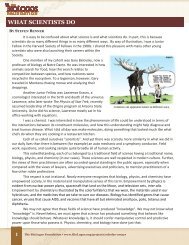Miracles and Science: The Long Shadow of David Hume - BioLogos
Miracles and Science: The Long Shadow of David Hume - BioLogos
Miracles and Science: The Long Shadow of David Hume - BioLogos
Create successful ePaper yourself
Turn your PDF publications into a flip-book with our unique Google optimized e-Paper software.
<strong>The</strong> <strong>BioLogos</strong> Foundation • www.<strong>BioLogos</strong>.org/projects/scholar-essays<br />
information about the world, how to separate fact from mere opinion, is indeed a very difficult <strong>and</strong><br />
important one.<br />
3. <strong>Miracles</strong> <strong>and</strong> the Bible<br />
How can we then judge whether or not the miracles <strong>of</strong> the Bible are reliable Since the word miracle has<br />
taken on so many different meanings, it is important to first examine the biblical language.<br />
<strong>The</strong> New Testament predominantly uses three words for miracle:<br />
teras, a wonder<br />
dunamis, an act <strong>of</strong> power<br />
semeion, a sign<br />
Sometimes it combines all three, as in Acts 2:22:<br />
Men <strong>of</strong> Israel, listen to this: Jesus <strong>of</strong> Nazareth was a man accredited by God to you by miracles<br />
(dunamis), wonders (teras) <strong>and</strong> signs (semeion), which God did among you through him, as you<br />
yourselves know.<br />
<strong>The</strong> word teras (wonder) is almost always used together with one <strong>of</strong> the other words, emphasizing that the<br />
main point <strong>of</strong> biblical miracles is not to merely elicit amazement but rather to serve a higher theological<br />
purpose. For this reason, biblical miracles cannot be understood outside <strong>of</strong> the theological context within<br />
which they occur. <strong>The</strong>y are not anomalous events. This principle provides a key to the proper assessment<br />
<strong>of</strong> their validity.<br />
Nature is what God does<br />
<strong>Miracles</strong> happen against a backdrop. In this context, it is illuminating to see how the Bible describes God’s<br />
action in the natural world. For example in Psalm 104, that great poem about nature, we read,<br />
He makes springs pour water into the ravines, it flows between the mountains<br />
<strong>The</strong> first part <strong>of</strong> this verse refers to God’s direct action while the second part suggests that water flows<br />
through its own natural properties. Read the Psalm for yourself <strong>and</strong> notice how fluidly the point <strong>of</strong> view<br />
changes back <strong>and</strong> forth between what we might call the laws <strong>of</strong> nature <strong>and</strong> the direct action <strong>of</strong> God. Such<br />
dual descriptions can be found throughout the Bible. <strong>The</strong> New Testament is even more explicit:<br />
<strong>The</strong> Son is the radiance <strong>of</strong> God's glory <strong>and</strong> the exact representation <strong>of</strong> his being, sustaining all things<br />
by his powerful word. (Hebrews 1:3)<br />
5<br />
<strong>Miracles</strong> <strong>and</strong> <strong>Science</strong>:<br />
<strong>The</strong> <strong>Long</strong> <strong>Shadow</strong> <strong>of</strong> <strong>David</strong> <strong>Hume</strong><br />
BY ARD LOUIS




